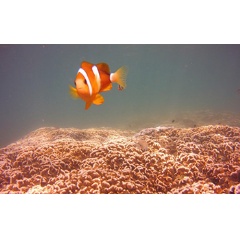Big differences in how coral reef fish larvae are dispersed
Research could help scientists improve conservation of species
How the larvae of colorful clownfish that live among coral reefs in the Philippines are dispersed varies widely, depending on the year and season, a finding that could help scientists improve conservation of these species.
Right after most coral reef fish hatch, they join a swirling sea of plankton as tiny, transparent larvae. Then currents, winds and waves disperse them, frequently to different reefs.
During seven years of surveys of clownfish on coral reefs, scientists measured how the dispersal of larvae varied over the years and seasonally, including during monsoons, according to U.S. National Science Foundation-funded research in the journal Molecular Ecology. The researchers found that larvae dispersal varied greatly on both time scales.
Their study suggests that when scientists account for dispersal variability rather than using data from a single year or an average over time, estimates of the persistence of fish populations will be lower.
“That means when we don’t account for dispersal variability, we could be overestimating the stability of coral reef fish populations,” said lead author Katrina Catalano, a researcher at Rutgers University in New Jersey. “If we study dispersal variability in more species over greater time scales, we will better understand what causes the variation and can better design protected areas for the conservation of species.”
Many studies measure patterns of larval dispersal, but often in only one year and don’t account for how dispersal might differ over time.
The scientists conducted a genetic analysis to detect larval dispersal events in a common coral reef fish, Amphiprion clarkia, also called the yellowtail clownfish and Clark’s anemonefish. The fish and their larvae live along nearly 20 miles of coastline at 19 reef sites in Ormoc Bay, Leyte, Philippines. The surveys ran from 2012 to 2018, in partnership with Visayas State University in the Philippines.
( Press Release Image: https://photos.webwire.com/prmedia/7/269687/269687-1.jpg )
WebWireID269687
This news content was configured by WebWire editorial staff. Linking is permitted.
News Release Distribution and Press Release Distribution Services Provided by WebWire.
